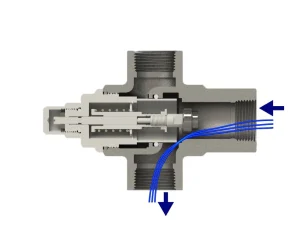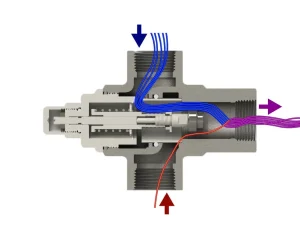A mixing valve is a mechanical device that controls fluid temperature, commonly water, lube oil, or hydraulic fluid, by blending hot and cold fluids to provide a consistent output temperature. They are crucial in various industrial, aerospace, and defense systems where precise fluid temperature control is necessary.
This article provides an overview of mixing valves: types of valves, how they work, and applications for use.
Types of Mixing Valves
Two primary categories are motorized and thermostatic mixing valves.
Motorized mixing valves, also known as motorized or electronically controlled valves, use an electric actuator or motor to adjust the position of the valve’s internal components. This motorized adjustment allows precise control over the hot and cold fluid ratio, which regulates the outlet temperature.
Motorized mixing valves are often controlled electronically through a dedicated controller and are commonly used in commercial and industrial settings where accuracy is paramount. They are frequently used in applications requiring integration with automation systems, such as large-scale HVAC (heating, ventilation, and air conditioning) systems.
Thermostatic mixing valves use a thermal element, such as a wax-based cartridge, to adjust the mixing valve automatically based on fluid temperature. The thermal element expands or contracts in response to temperature fluctuations, which regulates the flow to maintain a consistent output temperature.
Thermostatic mixing valves are self-actuating and do not require external power to operate. They are commonly used in engines, compressors, lubrication oil cooling systems, hydrostatic drive circuits, radiators, and hydraulic power units (HPUs).
The primary difference between these types of mixing valves is the control method. Motorized valves use electric actuators and electronic control systems, while thermostatic valves rely on self-operating thermal elements.
How Does a Mixing Valve Work?
A mixing valve usually has three inlet connections: one for hot flow, one for cold flow, and one for the mixed fluid outlet. The 3-way control valve modulates between the hot and cold inlet feeds (ports “B” and “C”) to mix your fluid to the desired specified temperature exiting the “A” port.
The mixing valve would ensure the fluid remains within the optimal temperature range, preventing overheating or excessive cooling. Such temperature extremes could result in system malfunctions or damage.
When temperatures surpass recommended limits, fluid viscosity decreases, leading to issues like poor lubrication, seal degradation due to thermal stress, and even occurrences of pump cavitation or failure; conversely, fluid viscosity increases when temperatures fall below the recommended range, causing undue stress on internal components due to insufficient lubrication.
Mixing hot and cold fluids in controlled proportions helps maintain consistent temperatures, ensuring efficient operation and longevity of components.
Do I Need a Mixing Valve?
Mixing valves ensure uniform temperatures, prevent overheating, and enhance process efficiency, making them indispensable components in various applications in manufacturing plants, chemical processing facilities, and other industrial facilities.
Without the intervention of mixing valves, fluctuations in temperature could lead to detrimental outcomes such as component degradation, equipment malfunction, and even safety hazards.
Diverting Valve vs. Mixing Valve: What is the Difference?
A Diverting Valve controls flow between multiple outlets or pathways and directs it to different system components.
A Mixing Valve controls fluid temperature by blending hot and cold fluids to achieve a consistent and safe output temperature.
The primary distinction between mixing and diverting valves lies in their purpose: fluid temperature control vs. fluid routing. ThermOmegaTech offers a valve that can be used for mixing and diverting based on your application.
The flow direction of a port determines what makes it either a Mixing valve or a Diverting valve. For mixing applications, the valve will have two flow inlets and one outlet; in diverting applications, there is one inlet and two outlets.
Conclusion
In conclusion, mixing valves play a critical role in various industrial applications. They offer precise control over fluid temperatures and thereby enhance overall process efficiency.
Mixing valves’ versatility allows them to be applied in multiple settings, from large-scale industrial plants to smaller commercial systems. Whether regulating the temperature of water in a heating system, controlling the flow of coolant in an engine, or managing the temperature of hydraulic fluid in an HPU, mixing valves are essential in optimizing performance and ensuring reliability.
At ThermOmegaTech, we understand the importance of precise temperature control in industrial processes. That’s why we offer valves tailored to your or your customers’ needs.
Contact us today to discuss your temperature control needs, and let our expertise contribute to optimizing your operations with our compact, self-actuating valves.

